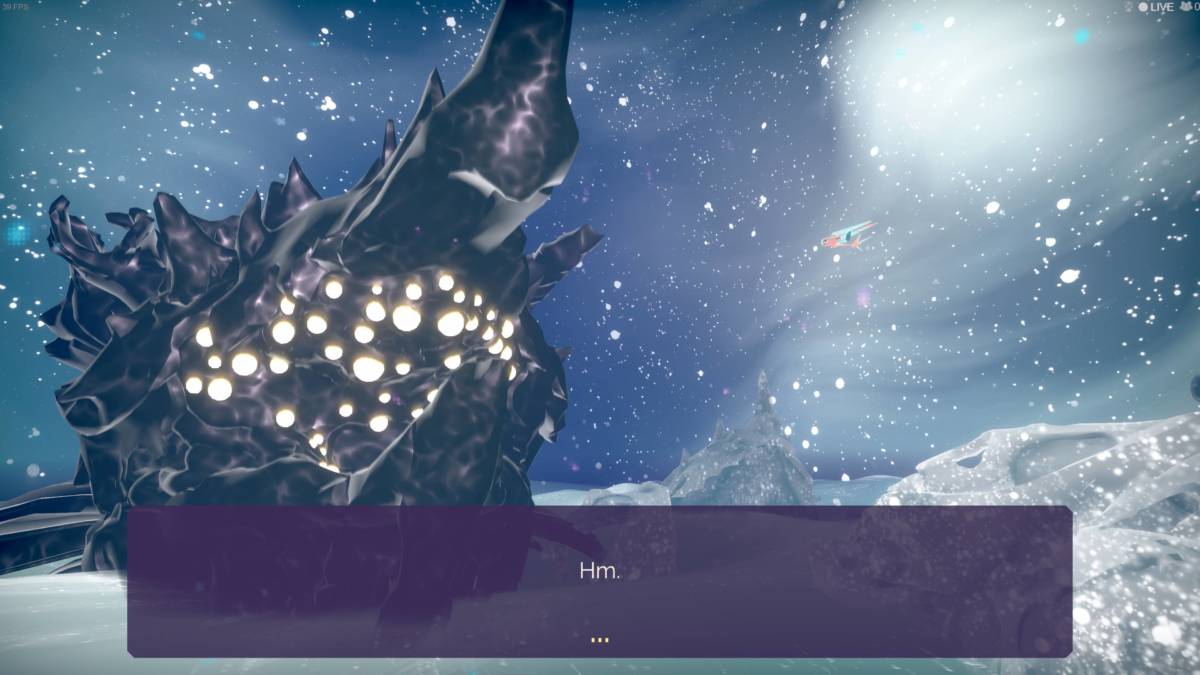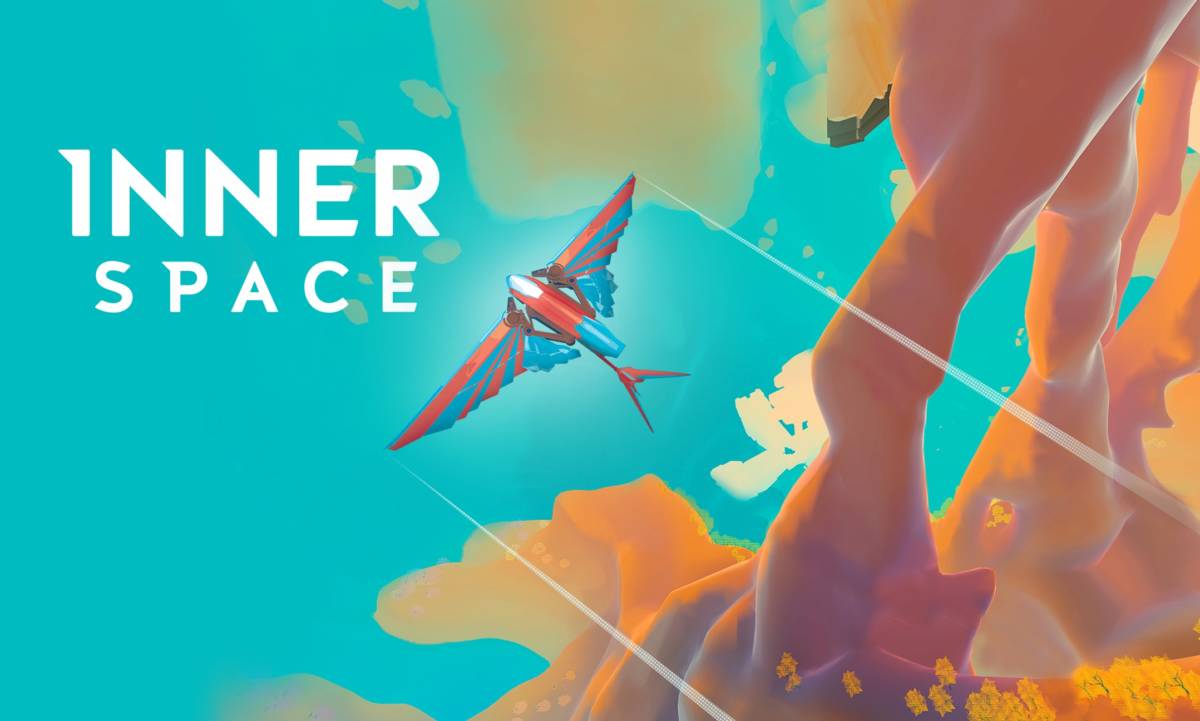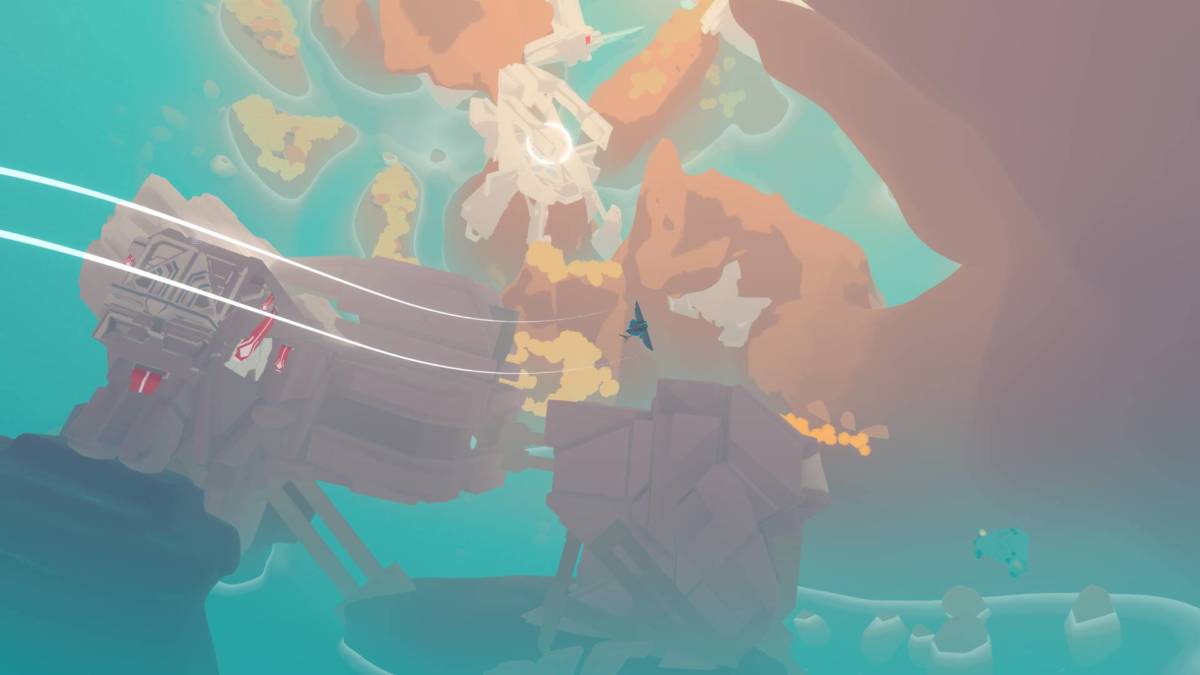Developer: PolyKnight Games
Publisher: Aspyr
Platform(s): PC, PS4, XB1, Switch
Review code provided
Some say the Earth is flat, but in InnerSpace, it’s inside out. As you fly around in these inverted worlds, which can be disorienting at first, you see only the remnants of a past civilization. Often, the only things stirring are you and your partner who built you out of wreckage of the Ancients. Loneliness is one of the two big themes of the game, along with the relationship between nature and technology. The music plays in with the second theme, with those multiple elements working together.
The gameplay is built fairly simply: fly. Fly around to your heart’s content, inside worlds, through water, around the same rock a few hundred times if you so wish. There are several models you can choose from here, ranging from a simple model that can only fly, which is a bit slower but it’s good for turning faster without having to drift, to a really fast model that can turn into a submarine and has a powerful drift that is almost as good as a brake. Drifting will come into play a lot later on, which is annoying if you don’t have your flying skills perfected.
Despite some annoyances in very narrow spaces, InnerSpace is essentially a very calming game. The closer you get to the end, the more tension there is, but the general feeling is very calm. From the music to the art style to the way the worlds are built, it’s a very chilled atmosphere. Despite being a flying game, it almost feels a bit slow at times, but not in a bad way. There are of course very fast-paced moments, but for the most part, the game is fairly slow. Design-wise, it’s full of bright colors, even in more grotesque areas. Parts of the world at the end of the game could have come straight out of one of Jack Kirby’s The Fourth World comics and were especially beautiful.
The one thing that will probably surprise the most people is the story, not because the story wasn’t expected, but because of the light-heartedness with which it tackles the theme of loneliness. The scenes where you talk with other characters more often than not hold more substance than expected from a small, calm flying game.
The Archaeologist, your partner in the game, created you out of wreckage they found stemming from the Ancients. There is no one else in the world where you start, despite it not being an inverted world yet. There are several bosses to be found, called Demigods, which the Archaeologist names as the reason why the Ancients died out, but there’s more to them than meets the eye. On top of it, these demigods are the last thing with any spark of life in these worlds and even then they require outside action to be awoken or revived.

As one of the Demigods says: “Wind is life.” Wind is what you collect in InnerSpace, be it from Demigods, from picking up bits and bobs in the area, or any other way. Wind is what keeps things moving, Wind can show you the way. Yes, that’s “Wind” with a capital W. It sounds absurd, but if the worlds are inside out, it feels within reach to say that there is a Force-like power in everything called Wind. Some of the talks with Demigods are much more interesting purely because of the topic of Wind. The mechanics of the game are integrated well into the story.
You can also pick up these things called “relics”, hidden around the worlds, which will either help you get a new aircraft, or just tell interesting titbits of lore about the Ancients or the Inverse. Things like the scribblings of a madman who thought the world was round, or a piece of scrap still in good condition. They all have a story to tell.

The music has a very natural feel to its rhythm and melodies, like birds chirping, or wind flowing through a forest, but is played with synthesizers and other electronic instruments, which especially fits the theme of the relationship between nature and technology. This relationship is seen very well in the worlds. The Ancients were highly technologically advanced beings, but technology was also all they left behind in these worlds. Monuments that have grown together with the greenery they’re surrounded by and giant flowers that are part machine are just some of the countless examples of the merging of nature and technology over time in InnerSpace.
In general, InnerSpace is a very simple game, but it also as good as never tells you what to do. There are several planets where you find yourself without your partner, the Archaeologist, as you fly around the planets looking for the next thing to do. Thankfully, however, the worlds aren’t very big. It is still possible to lose yourself in them, especially before you get used to the controls and the feeling of the game, it can be very disorienting to see the same thing from hundreds of different angles. Combine this with not knowing what to do and it can lead to a lot of confusion. All in all, however, the puzzles are not very difficult, even with barely any clues leading to them.
For a comparison, it’s like a happier, less lonely version of Shadow of the Colossus in the way that it’s built, where bosses are meant to be interacted with just like the rest of the environment during the battle. Despite having bosses in a manner of speaking, there’s still no fighting, meaning that these boss “battles” are surrounded by the calm of nature, even when the situation reeks of tension.
InnerSpace is a very interesting game, but sadly a very short game with ideas that could easily have been expanded on. It’s fun to play, even if it’s a bit disorienting at times, but the themes the game talks about, even if only briefly, stand in contrast to the happy-go-lucky style of the game and the worlds themselves.
Some of the coverage you find on Cultured Vultures contains affiliate links, which provide us with small commissions based on purchases made from visiting our site.


